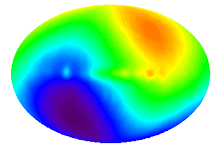The endothelium
The
adult human body contains at least one trillion endothelial cells, which weigh more than 100 g
and
cover a surface area of more than 3000 square meters
Think of the endothelium not only as an inert
blood container but as a vast endocrine gland. It stretches over the entire
vascular tree with a surface area of about 400 square metres,
of which most are in the capillaries. Its weight in an adult is about 1 ·5 kg and it contains an
estimated 1 ·2 trillion endothelial cells
it has become evident that the
endothelium is by no means a passive inner lining of blood vessels. This
'organ' with a large surface (approximately 350 m2 ) and a comparatively small total mass (approximately 110 g ) is actively involved in vital functions of the cardiovascular
system, including regulation of perfusion, fluid and solute exchange,
haemostasis and coagulation, inflammatory responses, vasculogenesis and
angiogenesis.
The endothelial lining of blood
vessels presents a large surface area for exchange of materials between blood
and tissues, and is critically involved in many other processes such as
regulation of blood flow, inflammatory responses and blood coagulation. It has
long been known that the luminal surface of the endothelium is lined with a
glycocalyx,
The endothelial cell reacts with
physical and chemical stimuli within the circulation and regulates hemostasis,
vasomotor tone, and immune and inflammatory responses. In addition, the
endothelial cell is pivotal in angiogenesis and vasculogenesis. Endothelial
cell injury, activation or dysfunction is a hallmark of many pathologic states
including atherosclerosis, loss of semi-permeable membrane function, and
thrombosis. Cell facts: (1) Endothelium consists of approximately (1-6) x 10(*13) endothelial cells forming
an almost 1 kg organ. (2) They uniquely contain Weibel–Palade bodies, 0.1 μm
wide, 3 μm long membrane-bound structures that
represent the storage organelle for von Willebrand factor (vWF). (3) The
endothelial cell is not only a permeability barrier but also a multifunctional
paracrine and endocrine organ. It is involved in the immune response,
coagulation, growth regulation, production of extracellular matrix components,
and is a modulator of blood flow and blood vessel tone.

沒有留言:
張貼留言